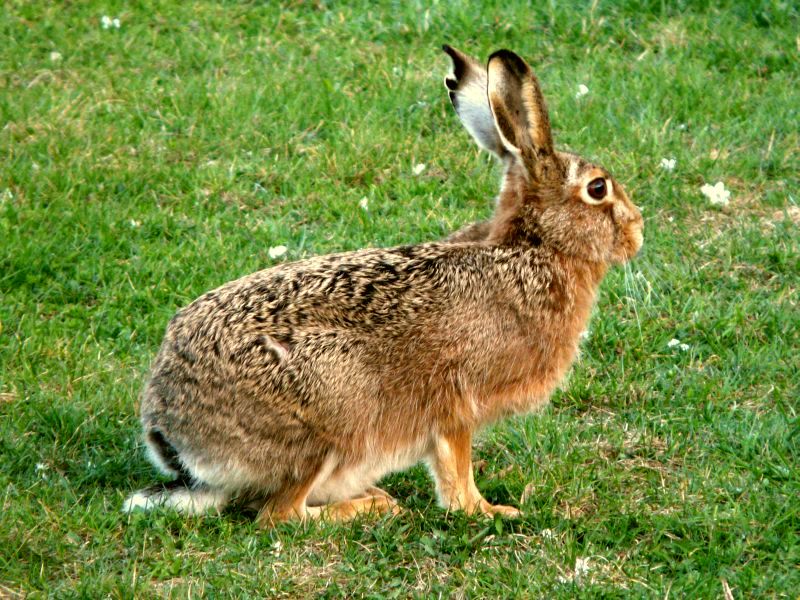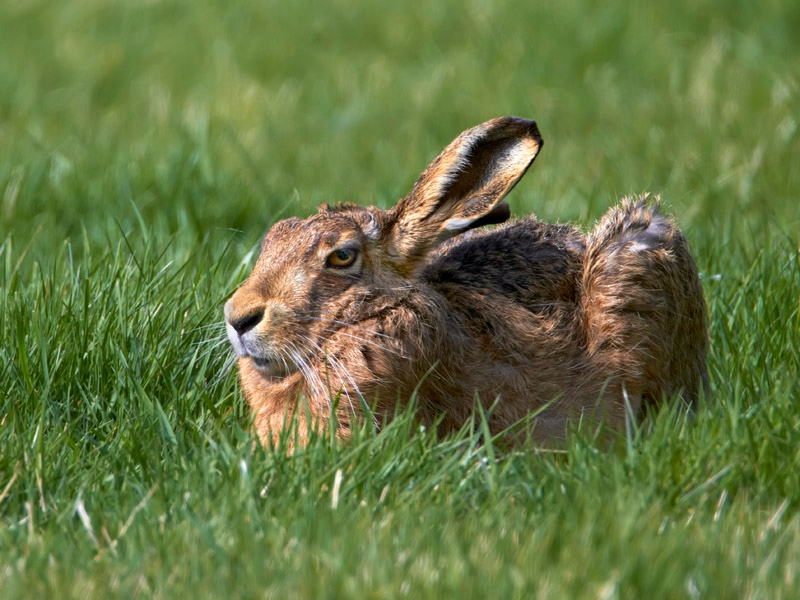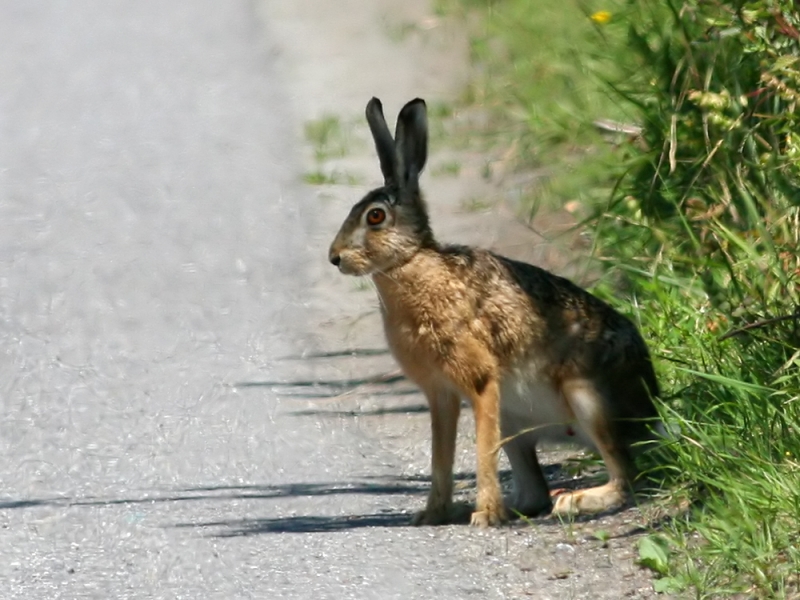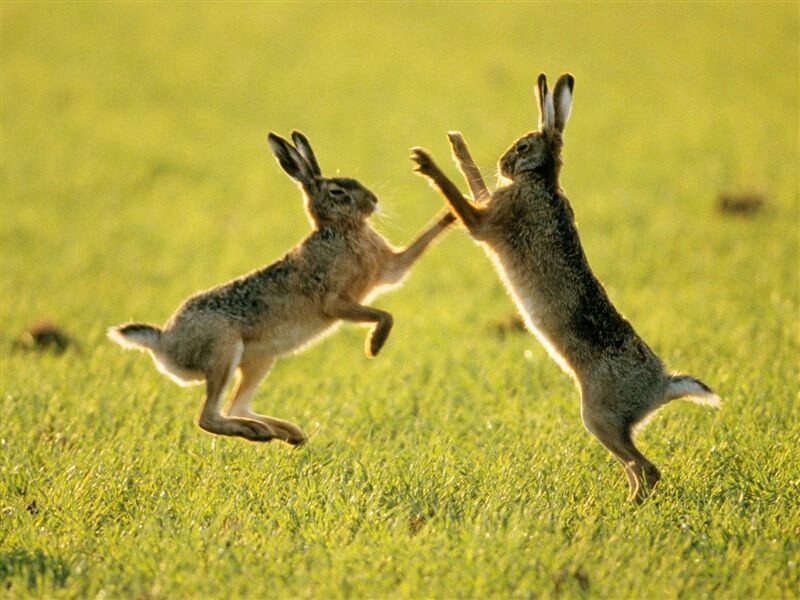| Legal Status |
Wildlife Act 1976 / 2000
| Key Identification Features |
The brown hare is much larger than its cousin the rabbit measuring up to 65cm in length including a 10cm long tail. The coat is variable in colour due to it being moulted twice per year, once in spring and once again in autumn. The summer coat is a light yellowish brown colour with a more reddish winter coat developing after autumn. The brown hare is often mistaken for the Irish mountain hare as they are similar in size and general appearance however the brown hare’s tail has a black stripe as opposed to the all white tail of the mountain hare species. Powerful hind legs can allow the brown hare to sprint at speeds of up to 70 km per hour for short periods if being pursued. They have strong senses of smell and hearing with excellent eyesight provided by large prominent eyes with a field of vision of 360 degrees. They are not a very vocal species but will emit a loud scream if distressed, they also emit a number of faint purring and snorting sounds when communicating. Female brown hares are generally 10% heavier than males weighing in at up to 3.5 kg. Brown hare tracks are grouped together in distinctive clusters of four prints which leave a Y-shaped impression ranging from 11 to 15cm in length with the hind feet appearing much larger than the fore feet. This species has four toes on each paw with fur covered soles leaving tracks much larger than that of a rabbit.
| Habitat |
Mainly a lowland species preferring flat countryside among open grass and farmland. Brown hares are most abundant in arable farmland areas which cultivate cereal crops. Brown hares use any available cover to rest and hide if threatened including woods, hedgerows and shelterbelts. The presence of livestock in high numbers can deter brown hares from using an area for their habitat. Unlike rabbits, brown hares do not burrow underground instead they use shallow depressions in open fields for dens known as forms which use long vegetation for cover. Once inside their forms only the head and back of the brown hare is visible. The home range of an individual brown hare may be up to 300 ha2 with territories of several individuals overlapping as this hare species is non territorial. Density numbers will vary depending on the quality of the habitat but there may be two to four individuals per hectare in some areas in Ireland.
| Food and Feeding Habits |
Brown hares are predominantly nocturnal but can be moderately active by day. During the summer months feeding can continue until late morning and early evening. The brown hare’s diet consists of mainly herb grasses and agricultural crops particularly the early growth stages of cereals and root crops. If available brown hares will browse on wild herbs and grasses located on foraging areas close to their dens. In winter when grass growth is reduced they will feed on bark from tree saplings or dig for turnips. Brown hares like other members of the Leporidae family of mammals will re-ingest their soft droppings giving them a second chance to break down and digest the tough cellulose which is found in their grass diets, this practice is known as reflection.
| Reproduction and Life Cycle |
Brown hares are generally solitary animals but breed throughout the year with a peak in pregnancies in mid summer. Courtship behavior can involve boxing matches which usually involve non-breeding females fending off the mating intentions of males during the spring or can occur between males who are attempting to gain social dominance. Fights between males are common and can be quite aggressive with successful dominant males mating with several females. On average breeding females produce three litters in a year between the months of February and October. The young brown hares are called leverets and each litter contains three to four young on average. Gestation in brown hares generally lasts for 42 days but females can mate and conceive again while already pregnant which is unusual for mammals. When the young are born they are fully furred and have their eyes open, weighing around 100 grams, the young leverets only need feeding once a day and are fully weaned after only three weeks. Leverets are left alone during the day in forms to avoid predators with the mother returning at sunset to suckle. The mortality rate for young brown hares in Ireland can be as high as 80% in their first year. Male brown hares reach full sexual maturity after only six months with the female hares needing eight months to fully develop. Life spans can reach a maximum of 13 years with an average of 7 years in the wild for Irish brown hares.
| Current Distribution |
The brown hare is believed to have originated in central Asia before moving westward to Europe and Ireland. They have been recently introduced to New Zealand, Australia and North America. The species was most likely introduced to Britain by the Romans before being brought to Ireland in the 19th century as a game animal on large country estates, they have now spread to most counties that support suitable habitats. They are absent from mountain areas due to it being less well adapted to survive winter conditions and from direct competition from the Irish mountain hare species. As their ideal habitat is mixed arable farmland they are more concentrated in the centre, south, east and some northern parts of Ireland but are absent from large areas of connaught as they do not breed well in peatland or on bog areas. Some isolated populations have arose due to the presence of coursing clubs such as those in counties Sligo and Donegal.
| Conservation Issues |
Brown hares are regularly shot and poisoned for being agricultural pests due to their habit of digging for root crops when winter snow and frost make grass grazing difficult. Agricultural hazards are numerous including the dangers posed by farm machinery and biocides, agrochemicals can have both a direct and in direct effect on brown hares, some farm chemicals can kill hares or reduce the diversity of their food supply by herbicide use. Brown hares in Ireland will also avoid grazing in the same areas as cattle and sheep so any increases in livestock numbers will reduce hare habitats. Brown hare populations have a rapid turnover so losses due to diseases can be high especially due to coccidiosis and yersiniosis. Road casualties may be a significant cause of death in some areas. Brown hares are considered a quarry species and may be hunted during the open season or captured and used for coursing with muzzled greyhounds, however illegal hunting can occur with the use of harrier and beagle dogs. Natural predation from foxes accounts for large losses in leverets each year. As the brown hare is not considered to be a member of Ireland’s natural fauna it has not being afforded full legal protection although this mammal is important as a prey species for larger native carnivorous mammals and some predatory birds.



